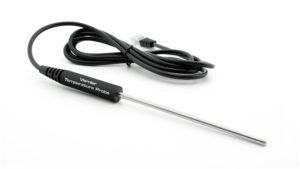On Peter Fox’s train rides into the city, he often gets to live every teacher’s dream: he bumps into former students who tell him how much they enjoyed (and still remember) his mathematics and physics classes. Fox, who has taught science and math at Elisabeth Murdoch College, Frankston High School, and the University of Melbourne in Victoria, Australia for the last 15 years, isn’t surprised. Ever since he introduced Vernier data-collection tools into his labs, he says learning has become exciting and long lasting.
“In the past,” notes Fox, “physics students conducted the same ‘recipe’ experiments over and over. This wasn’t real science! Students were basically taking information in and regurgitating it in an exam. But a year later they’d completely forget what they’d learned. Ever since I started using the Vernier products, a metamorphosis has taken place. Our experiments are investigative and student-focused – I do less teaching, and they do more learning.”
“Our experiments are investigative and student-focused – I do less teaching, and they do more learning.”
For example, Fox’s math and physics classes typically grab a digital camcorder, head out to the athletic fields, and videotape each other tossing, kicking, and catching a ball. Upon returning to the lab, they use the video capture and analysis features of Logger Pro software to help determine the X, Y, and time coordinates of the ball’s motion.
“Logger Pro makes it so easy to plot the path of the object!” Fox says. “The kids can really see that they can get the X and Y coordinates, and that both are dependent on time. And the coolest thing is, two years from now they’ll actually remember the experiment.
“I’ve never had anyone come up to me and tell me how much they’ve enjoyed working from the textbook,” laughs Fox. “But they do tell me that they really relate to the real-world experiments we do with the Vernier data-collection products.”
“… They [students] really relate to the real-world experiments we do with the Vernier data-collection products.”
Fox usually brings his students up to speed on the Vernier technologies with directed investigations. One of his popular labs helps students determine the average daily temperature. Using Vernier’s Temperature Probes and CBL2s, students collect data throughout the day, then analyze the data using a variety of statistical measurements. They also use the information to see if the “mean” is the best-possible statistical measure for their data and compare the result with the weather bureau’s method of averaging the maximum and minimum temperatures only. While the Vernier tools make the data collection process automatic and hassle-free, Fox says they also serve a bigger, more important purpose.
“Since gathering the data is so easy with the Vernier probes, students can focus on questions like ‘how often do we need to take measurements?’ and, even more important, ‘what’s the best way to tackle this problem?’” Fox reveals. “In this way the experiments become far more open, and truly encourage independent thinking. Sure, the kids can (and do) make mistakes; that’s part of the learning process. But the benefits of that type of investigation far outweigh any negatives.”
Fox’s advanced high school mathematics classes also have seen huge benefits with Vernier technologies. Previously, students had only posted overall scores in the mid- to high-30s (out of 50 possible points) on their proficiency exams. But after taking students through a series of experiments, such as a lab in Newton’s Law of Cooling using a LabPro, and encouraging students to solve the underlying differential equations, Fox says the class earned the best scores in the school’s 75-year history.
“The very best question I’ve heard is ‘are we doing math or science now?’” says Fox. “With the Vernier products, the boundaries between the two are becoming blurred. These types of investigations make mathematics come alive!”
This ability of Vernier data-collection technologies to make learning memorable is their greatest boon to both teachers and students, Fox believes. “If we want kids to remember things, they need to be doing, versus just reading and talking all the time,” he says. “And that’s precisely what Vernier allows them to do – shift from teacher-directed learning to self-directed investigations they can do themselves.”

